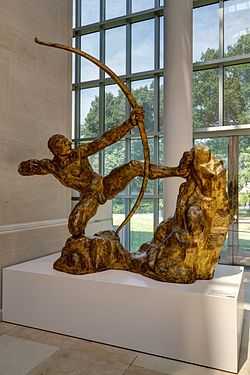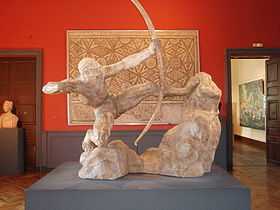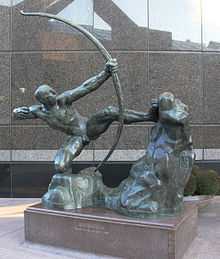Hercules the Archer


Hercules the Archer is a sculpture by Antoine Bourdelle, originally made in, which now exists in many versions. It was a commission of the financier and philanthropist Gabriel Thomas, as a single copy in gilt-bronze in April 1909; Bourdelle worked on the sculpture in the summer of 1909. It was cast by Eugène Rudier, and it was exhibited at the National Society of Fine Arts in 1910, and much appreciated. The dimensions were 2.50 m × 2.40 m.
The second version was developed around 1923. It differed from the first version with additions of reliefs on the rock right, representing the Lernaean Hydra and the Nemean Lion. Finally a banner along the base of the sculpture and the monogram completed the work.
Background

Bourdelle was inspired by the myth of Hercules, he chose the sixth of them : the extermination of the Stymphalian birds. In the Greek mythology, the birds of this lake were monstrous birds, feeding on human flesh, which infesting the woods surrounding the lake Stymphale, in Arcadia, using their sharp-pointed feathers bronze (according to one of several versions) as arrows, to kill men and beasts, and devour.
For the creation of this work, Antoine Bourdelle asked his friend the captain Doyen-Parigot (1854–1916), whom he had met at the "Saturday Rodin" to pose for him. This military man was an accomplished sportsman. The deployment of the body and muscle tension required by archery highlight the muscles of the model. Bourdelle modified the head of the model at the request of his friend who had requested for anonymity.[1]
Bourdelle did several studies to produce a small sculpture, which he considered as completed in 1909. During the visit to his workshop, the patron Gabriel Thomas was fascinated by this sculpture and commissioned a monumental sculpture for the garden of his home in Bellevue.
International success
In 1914, Antoine Bourdelle became aware of the injury suffered because of the exclusivity granted to Gabriel Thomas. Indeed, after the Venice Biennale where Bourdelle had presented a cast of Hercules the Archer, he was forced to refuse to sell a bronze statue. Seeing Bourdelle's disappointment, Thomas agreed to end his exclusivity and allow Bourdelle to make further copies. The first new sculpture went to Sweden in 1920. Thereafter, Thomas made a new bronze which remained in his family until it was sold in 1991 to Drouot-Montaigne, this work is now in Tokyo.
After Thomas' agreement to concede his rights, a copy was given in 1916 to the Gallery of Modern Art in Rome. In 1920, the museum Waldemarsudde of Stockholm bought the first copy of Thomas. In 1923, copies were sold to museums in Brussels, Prague and New York. In 1925, the city of Toulouse provided a Hercules statue for its sports museum. In 1926, the Musée du Luxembourg in Paris bought a Hercules (it is now at the Musée d'Orsay). In 1927, the Musée des Beaux-Arts de Lyon had a copy in turn. There are now a number of further versions in museums and cities.
Adolphe Willette made a caricature of the statue.[2]
France
- Paris, musée Bourdelle and musée d'Orsay[3]
- Montauban, musée Ingres[4]
- Toulouse, place Héraklès
- Lyon, Musée des Beaux-Arts de Lyon[5]
- Égreville, Jardin-musée Bourdelle d'Égreville
Asia
- Tokyo, Japon, National Museum of Western Art (NMWA) and musée Bridgestone Museum of Art
America
- Buenos Aires, Argentina, in a garden of the quarter Recoleta (the statue is named El arquero)
- New Orleans, Louisiana, Sydney and Walda Besthoff Sculpture Garden, New Orleans Museum of Art
- New York, U.S., Metropolitan Museum of Art.
Photos
The studies
-
The six studies of 1909
-
The first three studies
-
The next studies
-
The first study
The copies of the statue
-
.jpg)
El arquero in Buenos Aires, bronze
-
Hercules the Archer, bronze, musée Bourdelle in Paris
-
Hall of the plasters of the Musée Bourdelle in Paris
-
Hercules the Archer in Paris, musée d'Orsay
-
Hercules the Archer, jardin-musée Bourdelle, bronze
-

Hercules the Archer in Toulouse
Bibliography
- Dossier de l'Art N° 10 de January/February 1993
- Bourdelle by Ionel Jianou and Michel Dufet Edition Arted 1970
- Jardin-musée départemental Bourdelle d'Égreville by Hervé Joubeaux - Conservateur territorial du Patrimoine, May 2005 (ISBN 2-9524413-0-8)
References
- ↑ Héraklès archer Naissance d'une œuvre, Antoinette Le Normand-Romain, Paris Edition 666/1986
- ↑ Luc Willette, Adolphe Willette, Pierrot de Montmartre, Armaçon Ed., 1992
- ↑ http://www.musee-orsay.fr/fr/collections/oeuvres-commentees/sculpture/commentaire_id/herakles-archer-48.html?tx_commentaire_pi1[pidLi]=842&tx_commentaire_pi1[from]=729&cHash=4d3a089023 Retrieved 3 June 2009
- ↑ Toulousevisit.com Retrieved 3 June 2009
- ↑ Mistral.culture.fr Retrieved 3 June 2009
External links
| Wikimedia Commons has media related to Hercules the Archer. |
| ||||||||||||||||||||||||||||||







